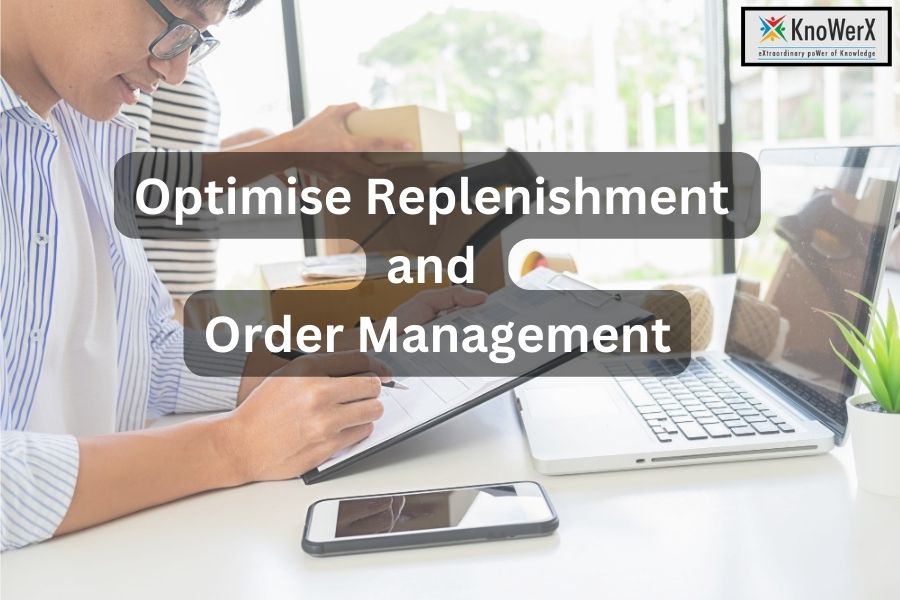How to Optimise Replenishment and Order Management Processes

In the complex world of supply chain management, replenishment and order management serve as the backbone of operational efficiency. These processes ensure that businesses maintain optimal inventory levels, meet customer demands on time, and minimise costs. A well-designed replenishment strategy, combined with effective order management practices, not only streamlines operations but also enhances customer satisfaction and profitability.
At KnoWerX, a leader in supply chain management training, we understand the critical role these functions play in modern business success. With over 32 years of collective experience, we specialise in equipping professionals with the skills and knowledge needed to optimise these vital aspects of the supply chain. Let’s explore key tips to master replenishment and order management for improved business outcomes.
1. Understand Demand Patterns
Replenishment and order management rely heavily on the analysis of demand patterns. Analyze historical sales to identify recurring patterns and seasonal changes. Use sophisticated demand forecasting tools to accurately forecast future needs to ensure that your inventory is neither overstocked nor understocked. Updates on the forecasts enable your business to be in line with market changes and customer preferences seamlessly.
2. Set Clear Replenishment Policies
Replenishment policies will help ensure optimal levels of inventory at all times. Set minimum and maximum stock thresholds to automatically generate replenishment orders, avoiding both stockouts and overstocking. Integrate safety stock policies to deal with sudden spikes in demand or disruptions in the supply chain. Automating these processes ensures consistency and minimizes human error in replenishment and order management workflows.
3. Optimise Supplier Relationships
Strong supplier relationships play a key role in efficient replenishment and order management. Team up with the suppliers to optimize the order processes and reduce lead times. Use the JIT replenishment strategy to cut down on the storage costs without compromising on time. Open communication with the suppliers ensures that the issues are tackled quickly, leading to a more smooth and reliable supply chain.
4. Leverage Technology
Technology is a game-changer in terms of improving replenishment and order management processes. Invest in advanced inventory management systems that can seamlessly integrate with your supply chain operations. Artificial Intelligence (AI) and Machine Learning (ML) tools will give you real-time insights and smarter decision-making capabilities. Cloud-based order management solutions increase visibility so that you can track inventory and orders across multiple locations effortlessly.
5. Monitor Key Performance Indicators (KPIs)
Tracking KPIs is essential to measure the effectiveness of your replenishment and order management strategies. Focus on metrics such as order accuracy, inventory turnover rates, and lead times to identify areas for improvement. Use these insights to fine-tune your processes, address inefficiencies, and achieve better alignment with business goals. Continuous performance monitoring ensures long-term success.
6. Train Your Team
A well-trained team is important to implement replenishment and order management practices. Invest in professional training programs that are equipped with the latest industry knowledge and tools for your staff. At KnoWerX, we have specific courses that aim to improve skill sets and foster professional growth. Empowering your team with expertise ensures smooth operation and competitiveness in the market.
Frequently Asked Questions
What is replenishment in supply chain management?
Replenishment involves restocking inventory to maintain optimal levels and meet customer demand. It ensures that stock levels are sufficient to avoid shortages or overstocking, contributing to efficient supply chain operations.
Why is order management important?
Order management ensures that customer orders are processed, fulfilled, and delivered accurately and on time. Efficient order management enhances customer satisfaction, reduces errors, and optimises supply chain performance.
How can businesses analyse demand patterns effectively?
Businesses can use historical sales data, advanced demand forecasting tools, and real-time market analytics to identify demand trends, seasonal variations, and customer preferences. Regularly updating forecasts ensures alignment with market changes.
What are replenishment policies, and why are they essential?
Replenishment policies set guidelines for maintaining inventory levels, such as minimum and maximum stock thresholds and safety stock requirements. These policies prevent stockouts, reduce overstocking, and ensure smooth inventory operations.
Ending Notes

Mastering replenishment and order management can really boost the operational efficiency of your business and the satisfaction of its customers. By implementing these tips, you will be able to optimize your supply chain processes and stay ahead in a competitive landscape. At KnoWerX, we are committed to helping professionals excel with top-notch training and industry expertise. Let us guide you toward supply chain excellence!
Image Reference : Freepik
Disclaimer: All trademarks, logos, and brand names are the property of their respective owners. All company, product, and service names used in this website are for identification purposes only. Use of these names, trademarks, and brands does not imply endorsement.



